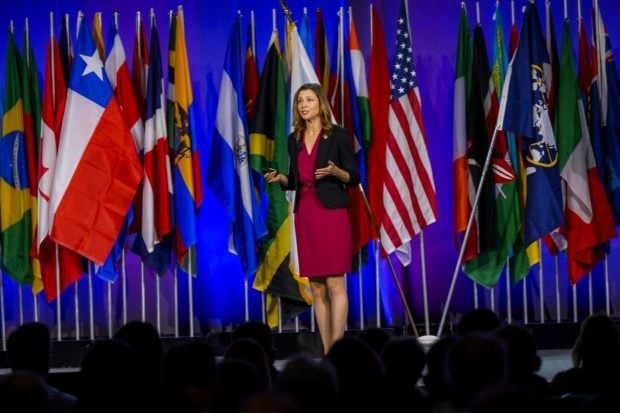WEST PALM BEACH, Fla. – Looking at your member demographics and think you know who has kids? Well don't be so sure. "Yesterday's `Ozzie and Harriet' or `Father Knows Best' definition of family has changed and evolved into grandma taking care of grandkids or a sister taking care of the kids, not necessarily just mom and dad-so it is possible to misconstrue the demographics," said Cynthia Grow, visioneer/creativity and imagineering vice president of Cincinnati, Ohio-based design/build firm DEI. "That is one of reasons we suggest a credit union designate a specific kid's area in a branch." Paul Seibert, principal of strategic facility planning firm Emick, Howard & Seibert, Inc., adds that in the last 10 years there has also been a big change in just who is having kids. "Whether it is through adoption or professional women age 35-40 who opt to have a child later on in life -a lot of people between the ages of 35-55 are just starting their families," said Seibert. "And this group tends to be more affluent with a high income and high lending opportunities so a kids' area provides yet another way to connect with that group." A recent Washington Mutual study finds that over 50% of consumers come into a branch with a child. According to Seibert, 75% of all people consider a bank or a credit union a primary financial institution if a branch is located within five miles of where they live or work. Credit unions have a unique opportunity to tap into this target market. "Look at some examples of successful kids' areas," said Seibert. "The McDonald's play area is just one. Although my son doesn't watch commercial television, if we drive by one he sees it and wants to go in there. It isn't about the burger but creating a powerful connection with the play." Experts agree that making the credit union branch environment one that is extremely comfortable to be in for children has a great value not just to the child but also emotionally reaches the parent or guardian. "Here is a perfect example, at Red Rocks Federal Credit Union we created an interactive child area and one mother came in just to drop off her husband's auto loan payment," said Grow. "She had all her accounts across street with a bank and when she came in her child ran to the `Zoofari' area filled with large cutouts of animals, a bamboo `gate', a cutoff tree trunk for a table etc. Do you know that woman not only stayed for an hour at the branch but also said `No one has ever made my child feel so welcome, and I didn't realize the advantages of a credit union'." According to Grow, if member service representatives are given the chance to talk to a member for 10-15 minutes and explain the credit union advantage over banks that person will become a member for life. Within one month of the Red Rocks branch opening one out of three people that walked through the door opened an account. For people with children the best way to get that chance is to really engage the children. Seibert suggests that credit unions begin to think of ways to connect with the children right when they walk in the branch. Certain elements such as unusual toys fixed in place so they don't become a hazard for other members; short video segments of sing-along songs or cartoons; books; and short-term computer games should be part of the "fun zone." The area can also be used to highlight any kids' club displays or even community/school events. Grow adds that the area does not have to be large or overwhelming, it could be as simple as having coloring books on a crate or having a few Nintendo Gameboys attached by a cord to a desk -as long as the child is fascinated by the activity and the adult can conduct business without distraction. Given the recent rash of kidnappings and general safety concerns, experts agree that in addition to fun the kids' area must be out of the path of traffic but located in an area of the branch that can be observed by the teller line, concierge and caf. "We know that you can't totally rely on parents to observe the kids," said Seibert. "But a good kids' area is still a lot safer than the alternative of children running around the branch, hanging on the ropes or pulling the ropes over their head and basically disturbing other members too." Seibert adds that within the area itself tables should have soft edges so if children trip they don't hurt themselves; chairs in that area must be light and easy to scoot; and kids should be able to look at it and say "that this looks like it was made just for me." "Make sure the area remains dynamic by determining who it is targeted to," said Seibert. "There should be different elements of change in it." Seibert looks to Norlarco Credit Union as an example. The whole branch plays up the brand of physical and financial fitness. The kids' area features a baseball table that looks like it has been thrown into the stone wall. There is a drinking fountain nearby and a space for a poster that can be switched out for award programs, kids' fair or any other kids' club promotions. The type of space and how it is configured plays a big role in creating a successful kids' area. One popular mistake is to make the area an enclosed room with glass walls. "Not only does it create a liability issue as to who is monitoring these children but it becomes a separate area that cannot be observed and is soundproof so adults are not able to hear the children, which is an uneasy feeling," said Seibert. "So no one uses the kids' area and the unused area then becomes nothing more than just a locked office or is later converted into a conference room." Grow agrees and adds other kid area `don'ts' including placing the area near a door; not considering hygiene -"little ones transfer germs all the time make sure you know how you are going to keep the area clean and as germ-free as possible" said Grow; and using small pieces or toys in the area. Perhaps the best reason to have a kid's area could be the spirit of fun it infuses into a financial institution that could otherwise be considered "serious" or conservative. [email protected]
© 2025 ALM Global, LLC, All Rights Reserved. Request academic re-use from www.copyright.com. All other uses, submit a request to [email protected]. For more information visit Asset & Logo Licensing.







